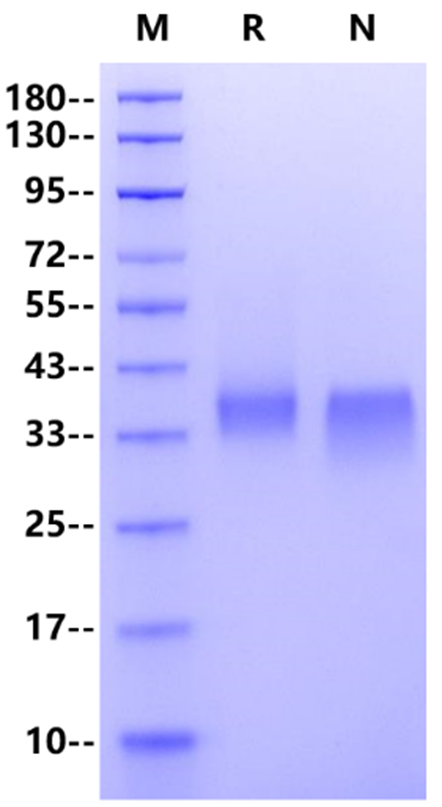Ile22-Val235, with C-terminal 8* His ISVETPQDVLRASQGKSVTLPCTYHTSTSSREGLIQWDKLLLTHTERVVIWPFSNKNYIHGELYKNRVSISNNAEQSDASITIDQLTMADNGTYECSVSLMSDLEGNTKSRVRLLVLVPPSKPECGIEGETIIGNNIQLTCQSKEGSPTPQYSWKRYNILNQEQPLAQPASGQPVSLKNISTDTSGYYICTSSNEEGTQFCNITVAVRSPSMNVGGGSHHHHHHHH
1.Sakamoto J., Kojima H., Kato J. Hamashima H., Suzuki H. Organ-specific expression of the intestinal epithelium-related antigen A33, a cell surface target for antibody-based imaging and treatment in gastrointestinal cancer. Cancer Chemother Pharmacol. 2000;46 Suppl: S27–32.2.Ackerman M.E., Chalouni C., Schmidt M.M., Raman V.V., Ritter G., Old L.J., Mellman I., Wittrup K.D. A33 antigen displays persistent surface expression. Cancer Immunol Immunother. 2008;57(7):1017–27.
GpA33 is a cell-surface differentiation antigen that belongs to the immunoglobulin superfamily. The GpA33 encodes a 319-amino acid polypeptide having a putative secretory signal sequence and 3 potential glycosylation sites. GpA33 antigen is a cell surface glycoprotein of the small intestine and colonic epithelium with homology to tight junction-associated proteins of the immunoglobulin superfamily, including CAR and JAM. Immunohistochemical study of normal tissues identified the large and small intestinal mucosa as the principal site of A33 expression. GpA33 is found in 95% of primary and metastatic colorectal cancers, with uniform expression throughout the tumors in most cases. Because of its presence only in the intestine or in tumors in the intestine, the gpA33 has been evaluated as a target for the detection and radioimmunotherapy of colon cancer tumors.
